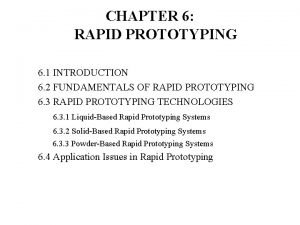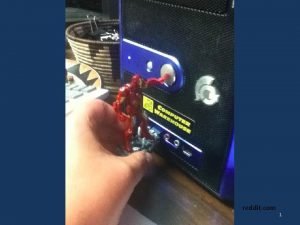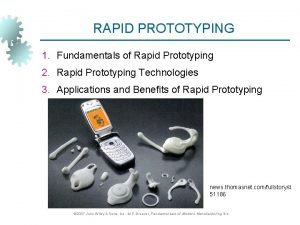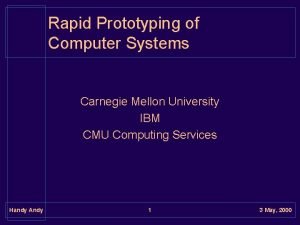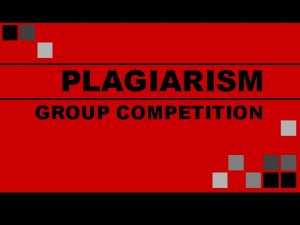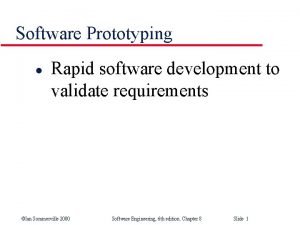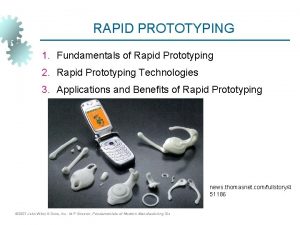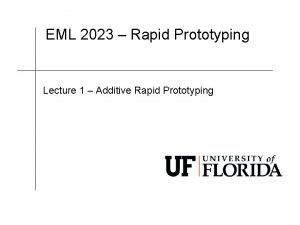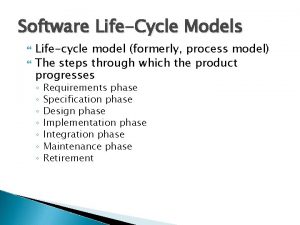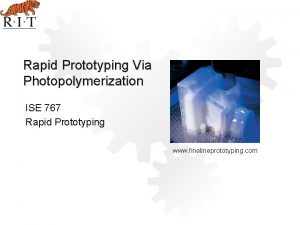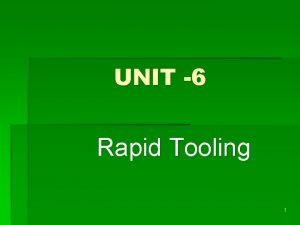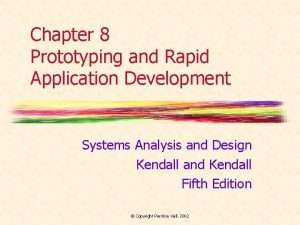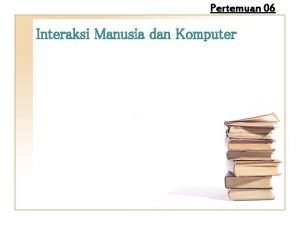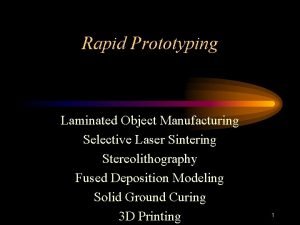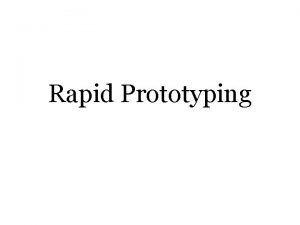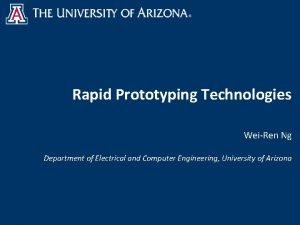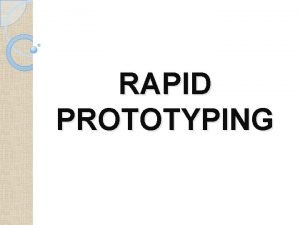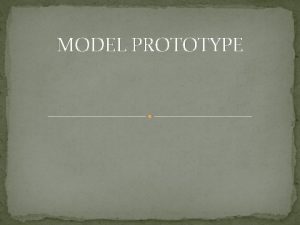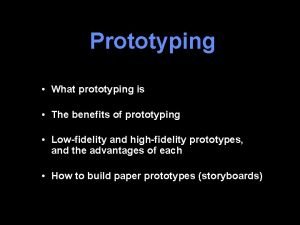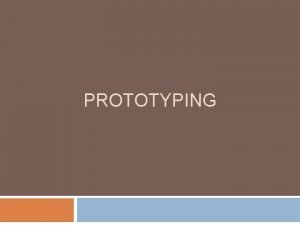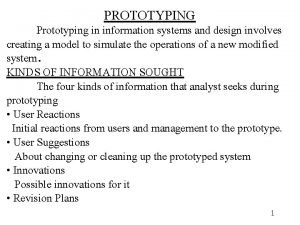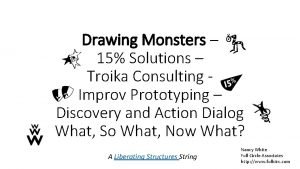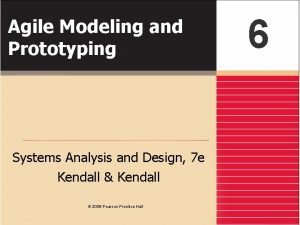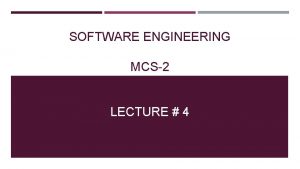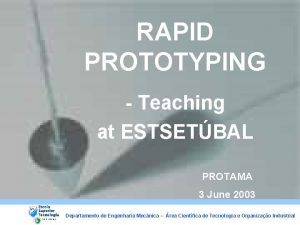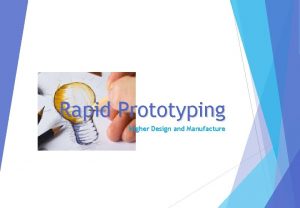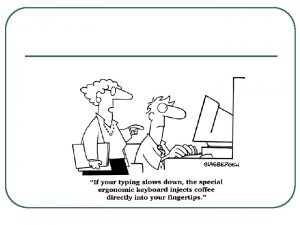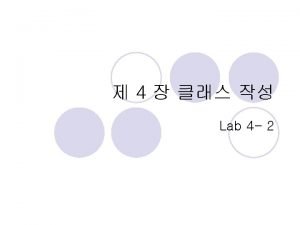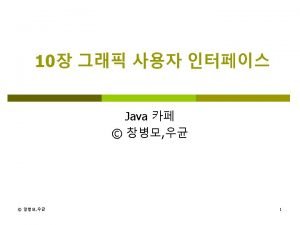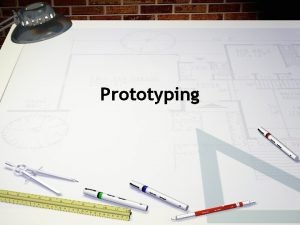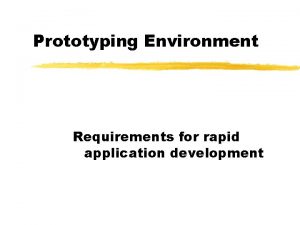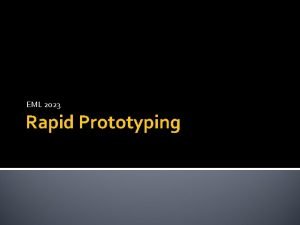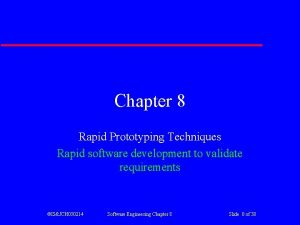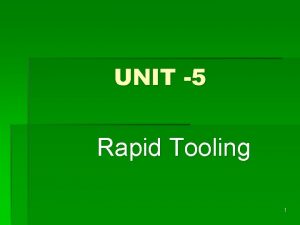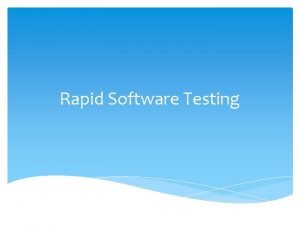Lecture 9 Rapid Prototyping GUI Prototyping What is































- Slides: 31

Lecture 9: Rapid Prototyping

GUI Prototyping What is prototyping? – rapid initial development, sketching & testing many designs to determine the best (few? ) to continue w/ further design & implementation Why do we prototype? – get feedback on our design faster • saves time! saves money! – experiment with alternative designs – fix problems before code is written – keep the design centered on the user

Progressive refinement Applications are iteratively refined – from less to more detail – from coarse to fine granularity Designers create representations of app, web sites, etc. at multiple levels of detail

Levels of prototyping Fidelity refers to the level of detail High fidelity – prototypes look like the final product Low fidelity – artists renditions with many details missing

Hi-fi prototyping ( implementation) IDE = Integrated Development Environment – provides editor, compiler, debugger, etc. – also provides “builder” for GUIs Example: Borland JBuilder – creating a new …?

Hi-fi prototyping ( implementation) – specifying the main application frame • what do you think this does?

Hi-fi prototyping ( implementation) – creation of the frame class(es) / file(s)

Hi-fi prototyping ( implementation) – refining the design

Hi-fi prototyping ( implementation) And continuing with implementation… – compiling and running the application – debugging – final production of the application (or applet, servlet, …)

Issues with hi-fi prototyping Advantages – don’t need to produce layouts from scratch – initializes all the basic component code, you fill in the functionality later Disadvantages – must give specific instance of a general idea • e. g. , exact widgets, fonts, alignments, colors – takes longer! – designers, evaluators focus on details instead of overall structure & functionality – code generation algorithms. Are they any good?

Why use low-fidelity prototyping? Traditional methods take too long – sketches prototype evaluate iterate Can simulate the prototype – sketches evaluate iterate – sketches act as prototypes • designer “plays computer” • other design team members observe & record Kindergarten implementation skills (? !) – allows non-programmers to participate

Paper sketches

Storyboards What are “storyboards”? – used in film & animation – provide a “script” of important events • leave out the details, concentrate on key interactions

Storyboards for designing GUIs – create / pin-up lots of screens – specify user interaction by associating screens

Paper sketches & storyboards Advantages – support brainstorming – do not require specification of details – designers feel comfortable sketching Drawbacks – – do not evolve easily lack support for “design memory” force manual translation to electronic format do not allow end-user interaction

“Electronic paper” sketching Quickly sketch this. . .

“Electronic paper” sketching Add behavior…

“Electronic paper” sketching Transform it to this…

SILK = Sketching Interfaces Like Krazy! Designer sketches ideas rapidly with electronic pad and pen – SILK recognizes widgets – easy editing with gestures Designer or end-user tests interface – widgets behave – specify additional behavior visually Automatically transforms to a “finished” GUI

SILK: Screens Screen = rough sketch of single screen state, including layout & components Features for handling screens – editing: use strokes to delete, move, group, … – history: save, restore, annotate – widget inference / recognition

SILK: Specifying behaviors Behavior = association of a screen object with another screen Specifying a behavior – put relevant screens in the “storyboard” – draw arrow from object to screen

SILK: Component recognition Infer / recognize components based on stroke-based gestures – scrollbar = long thin box + small inner box Difficulties – different strokes for different folks • different stroke(s) may produce same drawing, but may be recognized very differently! – requires that system be trained for specific user – more on recognition later. . .

SILK: Component composition When a component is recognized… – does the new component contain or is it contained by another component? – is the new component near another component? – is the new component in a sequence of components of the same type?

Another Tool: DENIM “A Tighter Fit with Web Site Design” Make SILK more useful to designers – technically: based on Java 2 for portability – functionally: support web design

DENIM: Creating pages

DENIM: Site map view

DENIM: Storyboard view

DENIM: Sketch view

DENIM: Run mode

DENIM: Additional tools Pan and zoom Pencils – Generic pencil for sketching – “Event pencils” for sketching arrows associated with particular events Rubber stamps – For inserting components – Built-in components (e. g. buttons) can be sketched

Discussion Would you use SILK? Why or why not? What might SILK be especially good for? What might it be not so useful for? Could we build a prototyping tool with the same goals but using a different modality? (e. g. , using speech instead of sketching)
 Ge gi gue gui güe güi
Ge gi gue gui güe güi Mexico rapid prototyping
Mexico rapid prototyping Powder based rapid prototyping
Powder based rapid prototyping Horizontal prototype
Horizontal prototype Liquid rapid prototyping
Liquid rapid prototyping Cmu rapid prototyping
Cmu rapid prototyping Rapid prototyping could be an advantageous methodology
Rapid prototyping could be an advantageous methodology Rapid prototyping software development
Rapid prototyping software development Waterfall 모델
Waterfall 모델 Solid based rapid prototyping
Solid based rapid prototyping Predictive maintenance wikipedia
Predictive maintenance wikipedia Uf rapid prototyping
Uf rapid prototyping Rapid prototyping
Rapid prototyping Software lifecycle models
Software lifecycle models Fineline rapid prototyping
Fineline rapid prototyping Polandball
Polandball Rad design workshop
Rad design workshop Bentuk awal contoh atau standar ukuran dari sebuah
Bentuk awal contoh atau standar ukuran dari sebuah Lom rapid prototyping
Lom rapid prototyping Define rapid prototyping
Define rapid prototyping Rapid prototyping
Rapid prototyping Rapid prototyping rp
Rapid prototyping rp Compare stl and slc file format
Compare stl and slc file format Rapid gui programming with python and qt
Rapid gui programming with python and qt 01:640:244 lecture notes - lecture 15: plat, idah, farad
01:640:244 lecture notes - lecture 15: plat, idah, farad Gambar model prototype
Gambar model prototype Benefits of prototype
Benefits of prototype Prototype design
Prototype design Patched up prototype
Patched up prototype Improv prototyping
Improv prototyping Agile modeling and prototyping
Agile modeling and prototyping Prototyping process in software engineering
Prototyping process in software engineering


